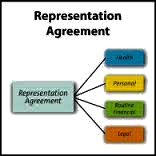Positions of dependence or domination are frequently involved in estate litigation and typically relate to caregiving or predator type behavior that ultimately takes advantage of feeble mind.
Elder Estate v Bradshaw 2015 BCSC 1266 involved a contested court action re the validity of the deceased’s will as a result of allegations of lack of mental capacity and undue influence.
The deceased left his entire estate to a 26 year younger housekeeper who gradually became his caregiver. The will was challenged by his three nephews who were his next of kin on an intestacy.
The decision is a good source of law relating to both the legal framework for proving the validity of a will in solemn form, as well as a review of undue influence, both with respect to a bequest left in the will and monies advanced to a joint bank account.
The court examined the evidence of several witnesses and concluded that there was no undue influence on the part of the caregiver with either the will or the joint bank account.
The deceased was elderly, had no next of kin and was almost reclusive. The relationship between the parties was over several years and the witnesses testified that their relationship was not suspicious in any manner. The evidence supported the caregiver’s position that she was his main source of emotional and physical support for many years, and he stated that he did not know what he would do without her.
It is somewhat surprising that the court does not adopt s. 52 WESA in its reasons for judgment relating to the issue of the shifting onus of proof re undue influence other than to say that the legal framework to prove the will in solemn form is still the law relating to the shifting burden of proof, despite the wording of s. 52.
It is almost impossible to separate the two issues of lack of mental capacity and undue influence as they are invariably intertwined in the facts. Probably the only undue influence case that might occur without there being lack of mental capacity is the situation of a cult were on person controls the minds of many.
THE LAW
[10] In Leung v. Chang, 2013 BCSC 976, Dardi J. summarized the pertinent authorities and legal framework for analyzing a proof in solemn form claim where issues of testamentary capacity and undue influence are raised:
Legal Framework of Proving a Will Valid In Solemn Form
[25] The Supreme Court of Canada in Vout v. Hay, [1995] 2 S.C.R. 876 clarified the principles with respect to the burden of proof in litigation regarding contested wills. The Court articulated the considerations which govern the interrelation of the doctrine of suspicious circumstances and the issues of testamentary capacity, knowledge and approval, undue influence and fraud.
[26] In an action for proof of will in solemn form, the party propounding the will must prove on a balance of probabilities that the will was executed in compliance with the statutory formalities, that the will-maker knew and approved of the contents of the will and that the will-maker had testamentary capacity: Vout at paras. 19-20.
[27] In order to make a valid will, the will-maker must have a “baseline level of mental acuity” or a “disposing mind and memory”, sufficient to appreciate and comprehend the nature and effect of the essential elements of the testamentary act. This encompasses an appreciation of the claims of the persons who are the natural objects of her estate and the extent of her property of which she is disposing: Laszlo v. Lawton, 2013 BCSC 305 at para. 185; Banks v. Goodfellow (1870), L.R. 5 Q.B. 549; Leger v. Poirier, [1944] S.C.R. 152 at 161. The assessment of whether a will-maker possesses testamentary capacity is a highly individualized inquiry and is a question of fact to be determined in all the circumstances: James v. Field, 2001 BCCA 267 at para. 51; Laszlo at para. 197.
[28] In certain circumstances, the propounder of the will, in discharging the burden of proof, is aided by a rebuttable presumption of validity. If the will was duly executed in accordance with the requisite statutory formalities after being read over to or by a testator who appeared to understand it, it is presumed the testator possessed the requisite testamentary capacity and knew and approved of its contents: Vout at para. 26.
[29] This presumption may be rebutted by evidence of “well-grounded suspicions”, referred to in the jurisprudence as “suspicious circumstances”, relating to one or more of the following circumstances:
(i) surrounding the preparation of the will;
(ii) tending to call into question the capacity of the will-maker; or
(iii) tending to show that the free will of the will-maker was overborne by acts of coercion or fraud: Vout at para. 25.
[30] If suspicious circumstances are established, then the presumption is spent and the legal burden of proof reverts to the propounder of the will. The propounder of the will then reassumes the legal burden of proving knowledge and approval, as well as proving testamentary capacity, if the suspicious circumstances reflect on the mental capacity of the will-maker to make a will: Woodward v. Grant, 2007 BCSC 1192 at para. 108. In order to discharge the burden, the propounder of the will is required to dispel the suspicious circumstances that have been raised: Ostrander v. Black (1996), 12 E.T.R. (2d) 219 at para. 30 (Gen. Div.).
[31] In Vout, the Court affirmed that if a court determines that suspicious circumstances exist, the applicable standard of proof is a balance of probabilities. However, the evidence must be scrutinized in accordance with the gravity of the suspicion raised in any particular case.
[32] In order to rebut the presumption of validity, those attacking the will must meet the threshold of demonstrating that there is some evidence “which, if accepted, would tend to negative knowledge and approval or testamentary capacity”: Vout at para. 27; Maddess v. Racz, 2009 BCCA 539 at para. 31. The court in Scott v. Cousins (2001), 37 E.T.R. (2d) 113 (Ont. S.C.J.) describes the requisite evidence as that which “excites the suspicion of the court”. A “general miasma of suspicion that something unsavoury may have occurred” is insufficient to rebut the presumption of validity; the evidence must raise a “specific and focused suspicion”: Clark v. Nash (1989), 61 D.L.R. (4th) 409 at 425 (B.C.C.A.).
[33] The court in Laszlo provides the following instructive observations regarding the doctrine of suspicious circumstances at para. 207:
Suspicious circumstances have been found to exist in a wide array of situations and are not necessarily sinister in nature. There is no checklist of circumstantial factors that will invariably fit the classification. Commonly occurring themes include where a beneficiary is instrumental in the preparation of the will (especially where the beneficiary stands in a fiduciary position to the testator), or where the will favours “someone who has not previously been the object of [the testator’s] bounty and does not fall within the class of persons testators usually remember in their wills, that is to say their next of kin.
Undue Influence
[34] When undue influence or fraud is alleged, the party opposing probate always bears the legal burden of proving on a balance of probabilities the affirmative defence of undue influence: Vout at para. 28. It is important to appreciate that in these circumstances, the doctrine of suspicious circumstances and the shifting of the burden of proof has no application.
[35] In order to invalidate a will on the grounds of undue influence, the asserting party must prove that the influence exerted against the will-maker amounted to coercion, such that the will did not reflect the true intentions of a free will-maker and was not the product of the will-maker’s own act. The undue influence must constitute coercion which could not be resisted by the will-maker and which destroyed his or her free agency. It is well-established on the authorities that if the will-maker remains able to act freely, the exercise of significant advice or persuasion on the will-maker or an attempt to appeal to the will-maker or the mere desire of the will-maker to gratify the wishes of another, will not amount to undue influence: Maddess v. Racz, 2008 BCSC 1550 at para. 324 aff’d 2009 BCCA 539; Freeman v. Freeman (1889), 19 O.R. 141 at 155 (C.A.); Scott at para. 112.
[11] I adopt this summary as accurate and applicable in respect of the issues regarding the validity of the 2011 Will in the present case. Paragraphs 34-35 of the quoted passage are no longer applicable to wills to which s. 52 of the Wills, Estates and Succession Act, S.B.C. 2009, c. 13 [WESA] applies, that is, where the will-maker died after March 31, 2014.










 A prospective client called yesterday inquiring whether three siblings who had joint tenancy with a fourth sibling, can force a sale so as to buy out the troublemaking fourth sibling.
A prospective client called yesterday inquiring whether three siblings who had joint tenancy with a fourth sibling, can force a sale so as to buy out the troublemaking fourth sibling.